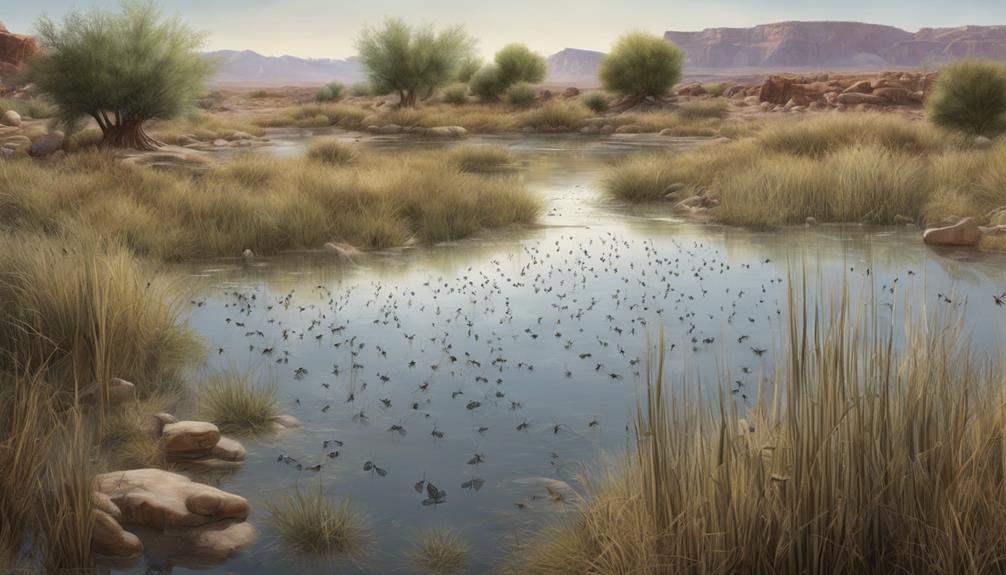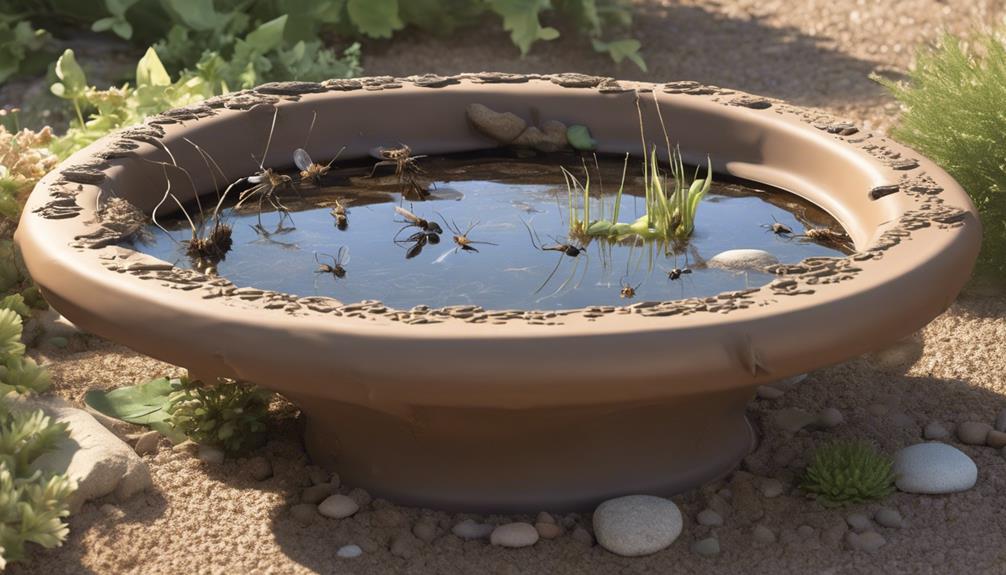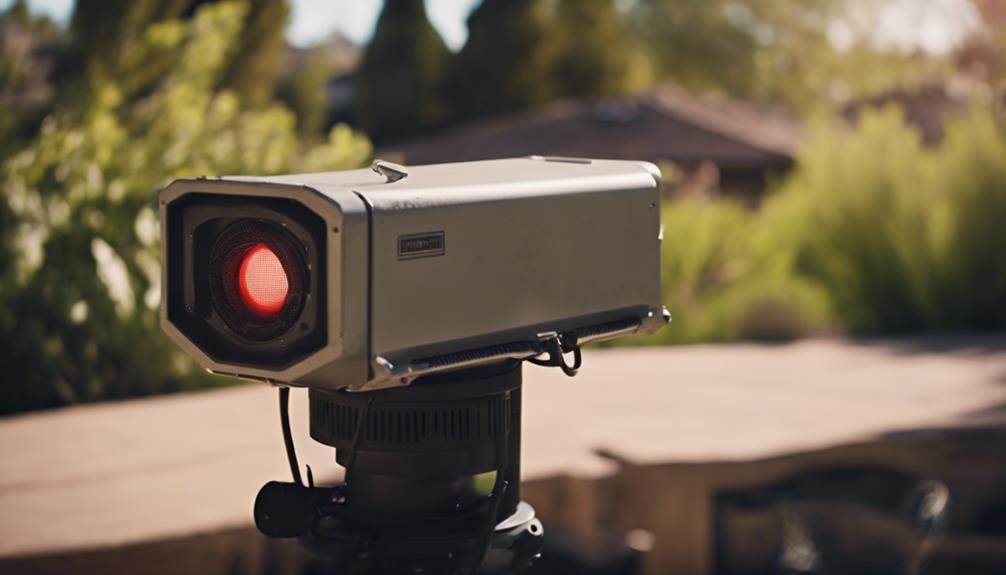Standing water in Southern Utah boosts mosquito populations, fostering rapid larvae growth. This surge heightens disease risks and disrupts the local ecology. Stagnant water promotes mosquito breeding, fueling disease transmission potential. Mosquito-borne illnesses like West Nile virus thrive in such environments, endangering human and animal health. Eliminating standing water is critical to curb mosquito reproduction and disease spread. These impacts on mosquito populations in Southern Utah underscore the necessity to address stagnant water for both health and environmental well-being.
Key Takeaways
- Stagnant water in Southern Utah accelerates mosquito breeding.
- Standing water increases disease transmission risks.
- Mosquito populations thrive in post-flooding stagnant water.
- Mosquito abatement teams work to reduce mosquito populations.
- Collaborative community efforts focus on eliminating mosquito breeding sites.
Mosquito Breeding in Stagnant Water

In stagnant water, mosquitoes thrive due to the important conditions it provides for their larvae to develop rapidly. Standing water, such as that found in puddles or containers, serves as a prime breeding ground for mosquito larvae. These stagnant water sources contribute greatly to the increase in mosquito populations, leading to a surge in mosquito activity.
The presence of mosquito breeding sites in standing water poses a challenge as it allows for the rapid reproduction and growth of these disease-carrying insects. To effectively control mosquito populations and reduce the risk of mosquito-borne diseases, it’s essential to eliminate stagnant water where mosquitoes breed. By removing these stagnant water sources, you can disrupt the mosquito life cycle, ultimately helping to mitigate the proliferation of mosquitoes in your area.
Risks of Standing Water Accumulation
Standing water accumulation poses a significant risk as it serves as ideal breeding grounds for mosquitoes. The potential for disease transmission escalates in areas with stagnant water due to increased mosquito populations.
Additionally, the environmental impact of standing water can lead to ecological disruptions and public health concerns.
Mosquito Breeding Grounds
When stagnant water accumulates, it becomes a vital breeding ground for mosquitoes in Southern Utah. Mosquitoes are drawn to still water to lay their eggs, resulting in an increase in mosquito populations.
Stagnant water, especially after flooding, provides ideal conditions for mosquitoes to breed, as it offers a suitable environment for mosquito larvae to develop. To prevent the proliferation of mosquitoes, it’s essential to remove any standing water sources promptly.
Disease Transmission Potential
Standing water accumulation greatly enhances the potential for mosquito-borne diseases to spread. In Southern Utah, stagnant water provides an ideal environment for mosquitoes to breed and multiply rapidly, increasing the risk of disease transmission.
Mosquito populations thrive in standing water, using it as their breeding grounds to lay eggs and complete their life cycle. The presence of stagnant water, especially after flooding, creates perfect conditions for mosquitoes to proliferate, leading to a higher likelihood of mosquito-borne illnesses.
To mitigate this risk, it’s important to eliminate standing water sources where mosquitoes can breed. By taking proactive measures to remove stagnant water, the transmission of mosquito-borne diseases can be significantly reduced in Southern Utah.
Environmental Impact Concerns
The presence of stagnant water, particularly in flood-affected areas, poses significant environmental concerns due to its role in facilitating rapid mosquito breeding and population growth. Mosquitoes thrive in standing water, laying eggs that hatch into larvae and contribute to increased mosquito populations in Southern Utah.
This surge in mosquito activity not only disrupts ecosystems but also raises the risk of disease transmission. Eliminating standing water is vital in combating the rise of mosquito populations and minimizing their environmental impact.
Disease Transmission via Mosquitoes
Mosquito-borne diseases pose a significant public health concern due to the potential transmission of illnesses like West Nile virus and St. Louis encephalitis to humans. Here are some key points to keep in mind:
- Mosquito Species: Over 50 different mosquito species in Utah have the capability to spread diseases through their bites, making it imperative to be vigilant.
- Breeding Grounds: Standing water serves as ideal breeding grounds for mosquitoes, allowing them to multiply rapidly and increase the risk of disease transmission.
- Preventive Measures: Avoiding mosquito bites is essential in preventing the spread of diseases like West Nile virus and St. Louis encephalitis. Using repellents and wearing protective clothing can help reduce exposure.
- Control Efforts: Mosquito control strategies focus on eliminating standing water sources to disrupt the breeding cycle, ultimately lowering the risk of disease transmission to humans. Implementing these measures plays a critical role in safeguarding public health.
Impact on Human and Animal Health

Increased mosquito populations resulting from the presence of standing water in Southern Utah pose notable risks to human and animal health. Mosquitoes breeding in stagnant water serve as vectors for diseases such as West Nile virus and St. Louis encephalitis, endangering the well-being of both residents and wildlife in the region. These diseases can be transmitted through mosquito bites, leading to severe illness and even fatalities in some cases.
Moreover, the disruption caused by thriving mosquito populations can have adverse effects on the ecosystem by impacting native wildlife populations and their habitats. To combat these risks, effective mosquito control measures are essential to minimize the impact of standing water on human and animal health in Southern Utah. By addressing the root cause of increased mosquito populations through targeted control strategies, the spread of disease and potential harm to both humans and animals can be greatly reduced, safeguarding the health of the community and local wildlife.
Strategies to Prevent Mosquito Breeding
To effectively mitigate the breeding of mosquitoes in Southern Utah, proactive measures must be implemented to eliminate standing water sources that play a vital role in mosquito reproduction. Mosquito abatement teams and homeowners play an essential role in preventing the proliferation of these disease-carrying insects.
Here are four strategies to help prevent mosquito breeding in Southern Utah:
- Regularly Drain: Make sure that any containers, such as buckets, flower pots, or birdbaths, are emptied frequently to prevent the accumulation of stagnant water.
- Cover: Use tight-fitting lids or screens to shield water storage containers to prevent mosquitoes from accessing the water for breeding.
- Clean Gutters: Regularly clean gutters and remove debris that can trap water, providing a breeding ground for mosquitoes.
- Maintain Landscaping: Trim vegetation and mow lawns regularly to reduce areas where water can collect and stagnate, thereby eliminating potential mosquito breeding sites.
Importance of Eliminating Water Sources

To effectively manage mosquito populations, it’s important to understand that standing water acts as a beacon, attracting mosquitoes for breeding.
Once stagnant water becomes a breeding ground, it facilitates the rapid growth of mosquito larvae, leading to increased mosquito numbers.
Water Sources Attract Mosquitos
Water sources, such as stagnant pools in buckets and gutters, serve as breeding grounds that attract mosquitoes seeking to lay their eggs. To understand the importance of eliminating these water sources, consider the following scenarios:
- A neglected flowerpot filled with rainwater becomes a haven for mosquito larvae.
- Clogged gutters after a storm create stagnant pools, ideal for mosquito breeding.
- Unused tires collecting rainwater transform into breeding sites for mosquitoes.
- Puddles left unattended post-rain provide ample opportunity for mosquitoes to reproduce.
Standing Water Breeds Mosquitos
Neglecting stagnant water sources inadvertently fosters mosquito populations, perpetuating the cycle of reproduction and infestation. Mosquitoes rely on stagnant water for breeding, making it imperative to eliminate such sources to control their populations.
Standing water serves as the optimal breeding grounds for mosquitoes in Southern Utah, facilitating their proliferation. To effectively manage mosquito populations, targeted efforts in mosquito abatement focus on areas with stagnant water.
Preventing the accumulation of standing water is vital in minimizing mosquito infestations in the region. By understanding the connection between stagnant water and mosquito breeding, you can take proactive steps to control mosquito populations and reduce the risk of infestations.
Eliminating Water Prevents Breeding
Standing water elimination is a critical measure in preventing mosquito breeding and population growth.
- Remove any containers: Dispose of cans, buckets, or any objects that can collect water.
- Clean gutters regularly: Guarantee proper drainage to prevent water accumulation.
- Check for hidden water sources: Look for areas like flower pots or bird baths that may hold stagnant water.
- Maintain swimming pools: Keep them treated or properly drained when not in use to avoid becoming a breeding ground.
Environmental Implications of Standing Water

Enhancing the understanding of the ecological repercussions of stagnant water provides essential insights into the intricate balance of local ecosystems. Standing water serves as ideal breeding grounds for mosquitoes, facilitating the development of mosquito larvae and leading to increased populations in Southern Utah.
The presence of stagnant water post-flooding further exacerbates mosquito activity in the region, creating environmental disruption. These wetland ecosystems, formed by standing water, not only support thriving mosquito populations but also impact wildlife and the overall equilibrium of the local environment.
The stagnant water not only offers a conducive environment for mosquitoes but also alters the dynamics of the ecosystem, potentially leading to imbalances in species interactions and resource availability. Understanding the environmental implications of standing water is crucial for comprehending the broader consequences on ecosystems and the wildlife that inhabit them.
Community Efforts in Mosquito Control
The management of mosquito populations in Southern Utah involves coordinated efforts between mosquito abatement teams and the local community to address breeding sites and potential environmental risks. Community involvement plays an essential role in the success of mosquito control strategies in the region.
- Mosquito Abatement Teams: These specialized teams are dedicated to reducing mosquito populations through targeted interventions and surveillance.
- Community Involvement: Active participation from residents in reporting and addressing areas with stagnant water helps in the identification and elimination of mosquito breeding grounds.
- Public Education Campaigns: These campaigns focus on raising awareness about the importance of removing standing water to prevent mosquito breeding, ultimately reducing mosquito populations.
- Local Authorities and Residents Collaboration: Collaboration between local authorities and residents ensures the effective implementation of mosquito control measures, leading to a more thorough and successful approach to reducing mosquito populations in Southern Utah.
Frequently Asked Questions
Why Are Mosquitoes so Bad This Year in Utah?
Mosquitoes are rampant in Utah due to increased standing water from flooding. Their breeding in stagnant water is prolific. However, the floodwater mosquitoes are not disease carriers. Mosquito control is vital for public health.
How Does Water Affect Mosquitoes?
When water stagnates, it becomes a haven for mosquito breeding. Larvae thrive, leading to population booms. Environmental changes impact these wetland habitats, influencing disease spread. Effective control over standing water can alter population dynamics to a great extent.
Do Bodies of Water Attract Mosquitoes?
Standing water, like wetlands, attracts mosquitoes for breeding, fostering mosquito larvae. Ponds and marshes provide ideal habitats for them. Water sources contribute to disease transmission. Population control, habitat destruction, and climate change impact vector management.
Do Mosquitoes Need Standing Water to Breed?
Yes, mosquitoes require standing water for breeding. Without it, their reproduction cycle is disrupted. Eliminating water sources is key to controlling mosquito populations. Standing water supports their larval stages, impacting their numbers and potential disease transmission.




